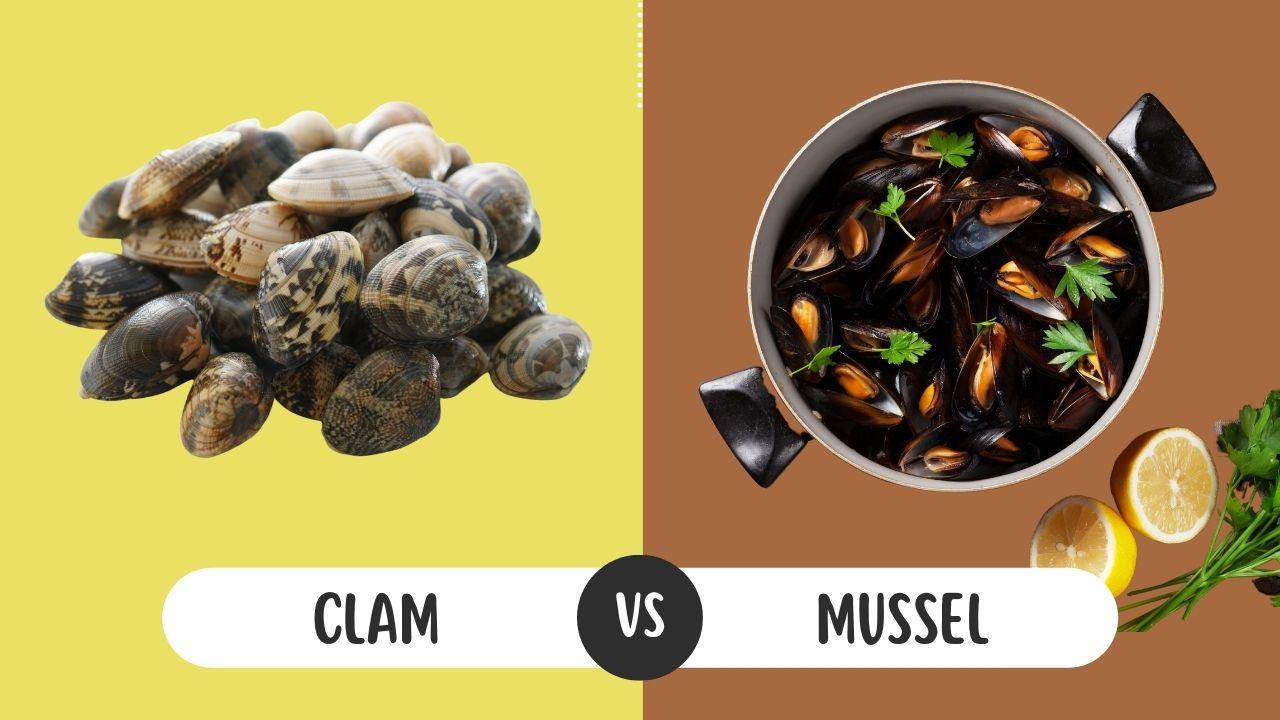Clam vs Mussel? I personally love both. The difference between clams and mussels is a widely discussed topic as both are darlings of seafood lovers.
However, if you’ve never tasted them or are a bit wary about eating them, here’s all you need to know about what differentiates clams from mussels to help you appreciate their taste better.
Without further ado, let’s dive in!
You may also like: Green Mussels vs Black Mussels: The Differences Will Surprise You!
What Is The Difference Between Mussels and Clams?
Is clam and mussel the same? Many of us who are not familiar with shellfish may have wondered about it.
While mussels and clams belong to the same family of bivalve mollusks, there are differences in their habitat, physical appearance, nutrition, price, and other aspects.
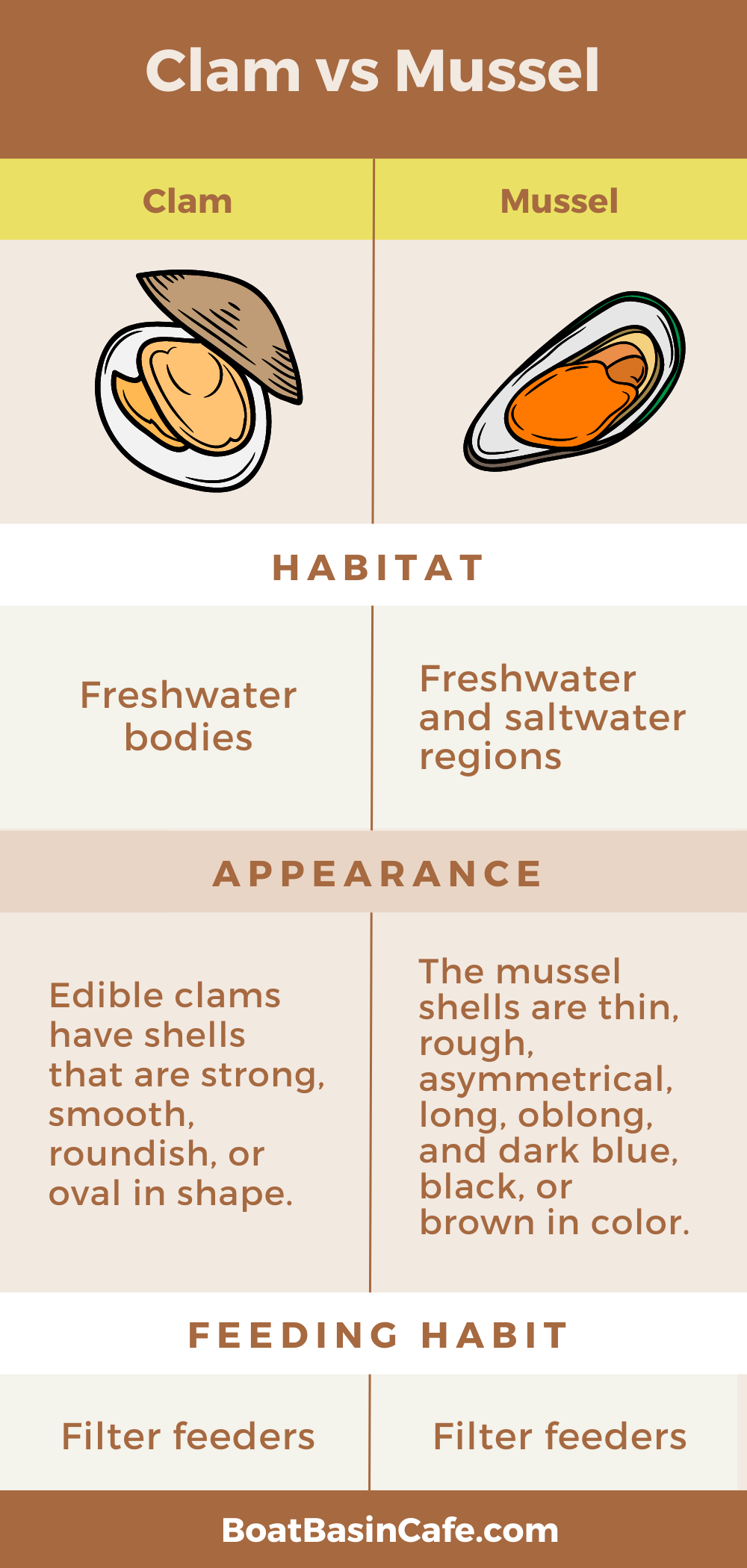
Habitat
Clams are found in freshwater bodies whereas mussels are found in both freshwater and saltwater regions. In fact, mussels are farmed mollusks that are widely available.
The foot of the clams helps them to burrow under sand or mud. That’s why you can find individual clams on sandy beaches.
Mussels have thin threads called byssal threads. They use these threads to attach themselves to other mussels or rocks. So, you’ll always find mussels in groups and they don’t move about as much as clams do.
Appearance
The mussel shells are thin, rough, asymmetrical, long, oblong, and dark blue, black, or brown in color. The inside of the shell is silver or gray.
There are three layers in the mussel shell – iridescent, prismatic, and periostracum.
The mantle secretes calcium carbonate to form the iridescent layer in pearly mussels. This inner part is white and shiny and is also called the nacre or “mother of pearl”.
The prismatic layer is also made up of calcium carbonate but in a crystal form.
The outermost part of the mussel shell is the periostracum. It’s made of protein, resembles the skin, and protects the shell.
On the other hand, edible clams have shells that are strong, smooth, roundish, or oval in shape. The two halves of the shells are symmetrical and are tightly closed with the help of two adductor muscles. Clamshells are white, brown, or light tan in color.
Razor clams are different in appearance although they belong to the marine bivalve mollusk family. They don’t have oval shaped shells. In fact, they are called razor clams because their shells are elongated and look like straight razors.
Another distinct difference is the presence of organs in the clams. They have a heart, digestive system, and circulatory system.
Feeding habit
Clams and mussels are both filter feeders. This means they filter the water around them to eat small food particles including algae and other aquatic organic matter.
They have two types of siphons in their bodies – inhalation and exhalation siphons. The inhalation siphon takes in water along with food. Clams trap the food particles from their gills and are passed on to the clam’s mouth.
The exhalation siphon passes out undigested food particles and other matter back into the water.
Fun Fact: Clams can filter up to 24 gallons of water per day!
Price
Mussels are cheaper than clams because they are commercially farmed with very low investment and maintenance costs.
Farmers don’t need to buy expensive foods for mussels and neither do they need special tanks to breed in.
As mussels reproduce at a fast rate and high numbers, they are more widely available, making them cheaper than clams by at least 50% per pound. Clams cost around $5 per pound whereas mussels are priced at $1.97 per pound at max.
Clams are more difficult to farm as they live under the sand and need to be given food. Moreover, they need to be protected from crabs, giving rise to farming costs.
Taste Comparison Between Clams and Mussels
As far as the texture is concerned, both clams and mussels are chewy.
Clams taste literally of the sea – salty, slightly sweet, and rich.
Mussels taste bland and not fishy at all. That’s why mussels are typically served in a sauce to balance their mild taste.
Personally, I love the natural salty taste of clams and it tastes amazing when paired with a buttery garlic sauce cooked in white wine.
But when I’m in the mood for something lighter, I go for mussels seasoned with fennel or saffron.
You see, it all depends on your mood and there’s no definite answer as to which tastes better – clams or mussels.
How to Cook Clams and Mussels
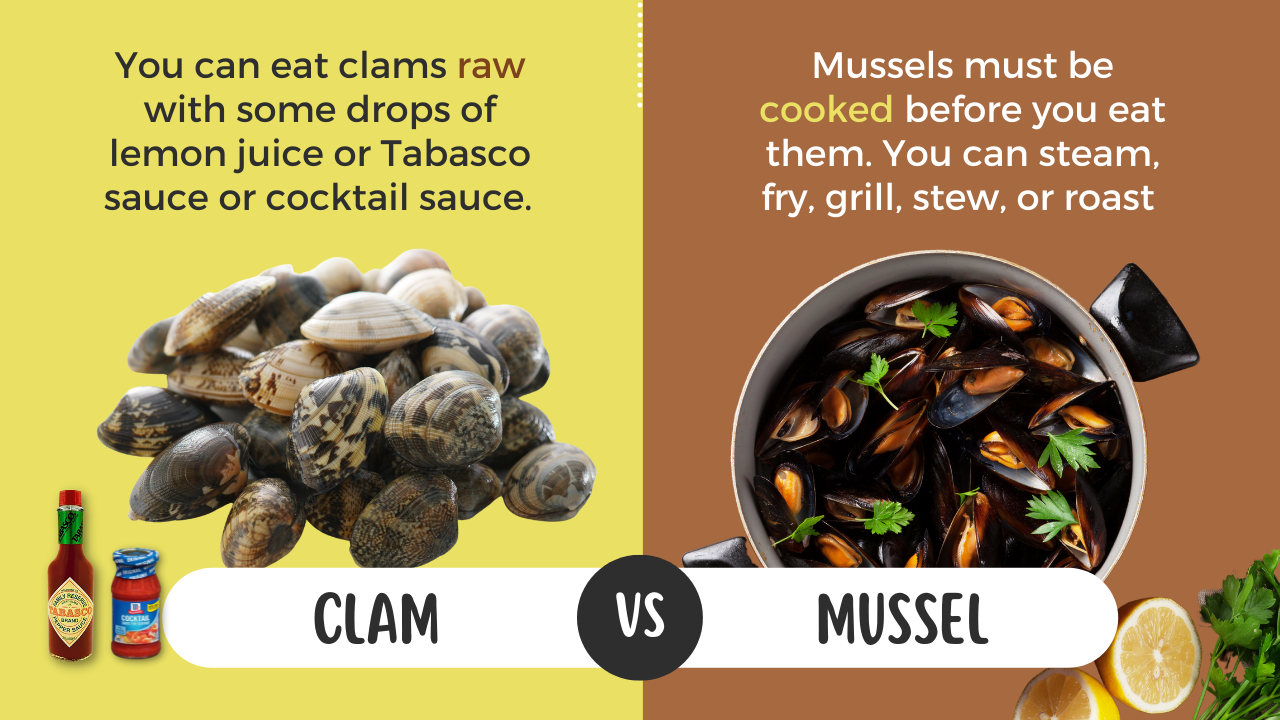
You can eat clams raw with some drops of lemon juice or Tabasco sauce or cocktail sauce.
However, mussels must be cooked before you eat them. Since mussels feed on plankton that may have bacteria and toxins, you should never eat raw mussels.
You can steam, fry, grill, stew, or roast both types of seafood. In fact, some connoisseurs go far as to stuff and bake clams and mussels.
Note: Clams take longer to cook than mussels.
While steaming is the easiest way to cook both clam and mussel, the clam is more popularly eaten as clam chowder.
Pro Tip: If you’re making white clam chowder, soak the clams in milk or cream before adding them to the heat.
Nutritional Information About Clams And Mussels
Both clams and mussels are good for you as they are full of nutrients including Omega-3 fatty acids, vitamins, and minerals.
Omega-3 fatty acids have lots of health benefits, especially related to heart health.
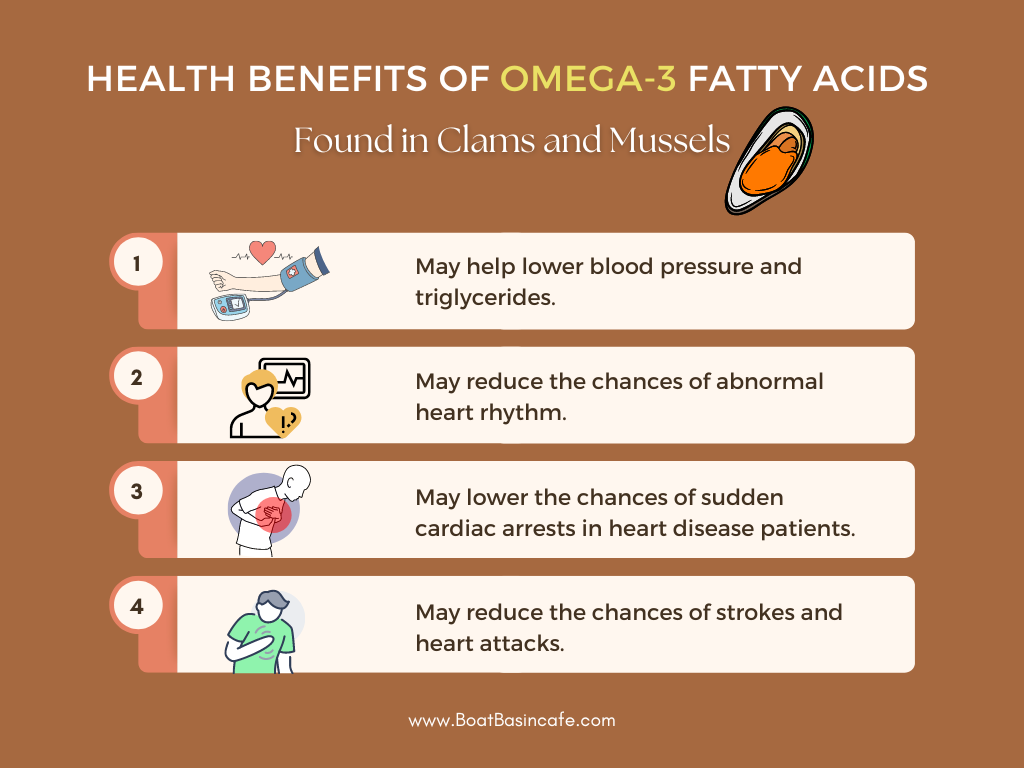
For a 3-ounce (85 grams) serving of clam or mussel, the nutrition facts are as follows:
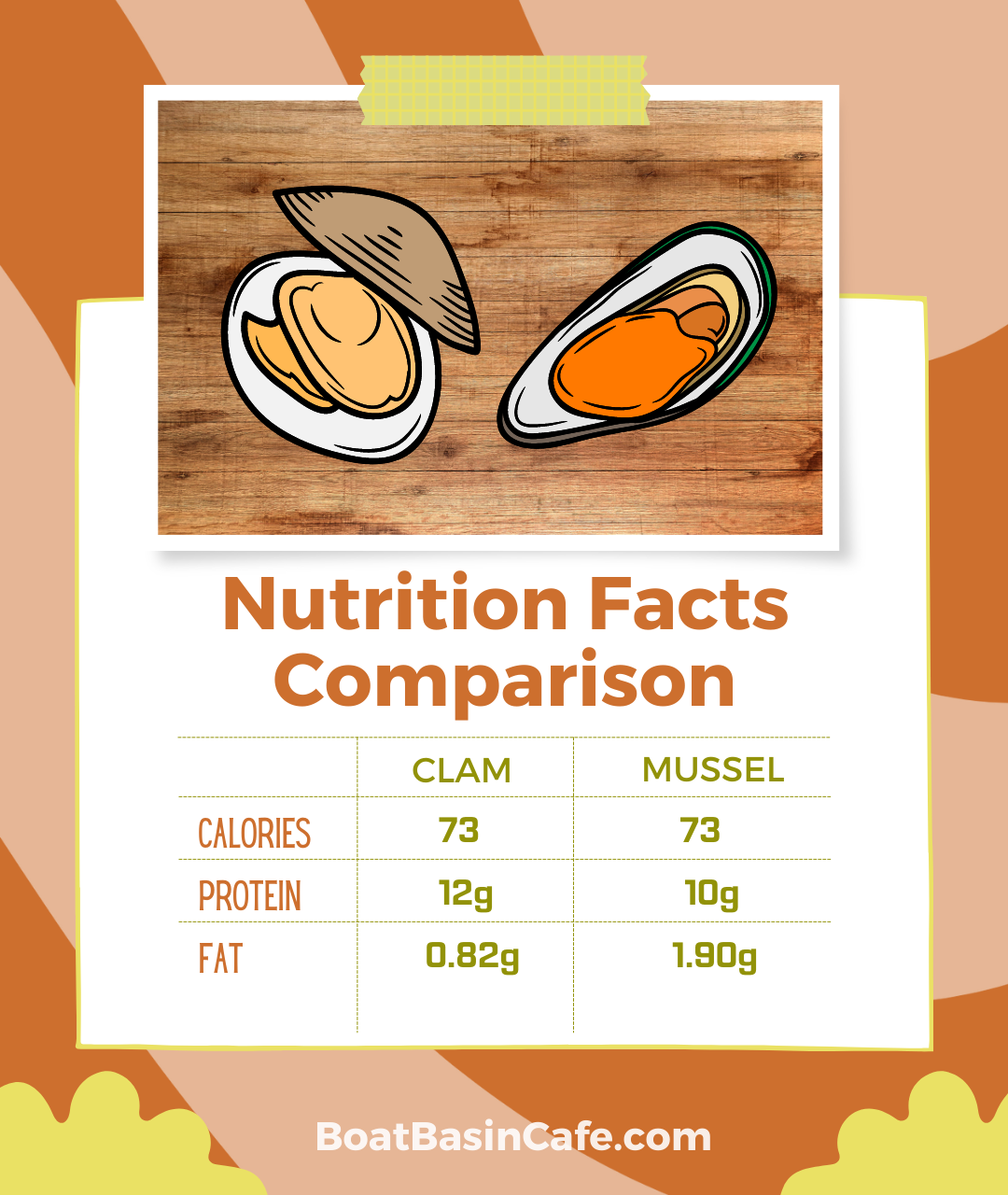
The nutrient profile of clams and mussels are not much different from one another, making them almost equally good for your health.
Both are good sources of proteins and score well on account of being low-calorie and low-fat foods.
Sodium content is lower in clams so if you have any dietary restrictions regarding salt, maybe you can skip mussels and settle for clams instead.
| 1 cup clams | 1 cup mussels | |
| Calories | 73 | 73 |
| Fat | 0.82 g | 1.90 g |
| Sodium | 130 mg | 400 mg |
| Protein | 12 g | 10 g |
Clams and mussels are also packed with essential vitamins and minerals including a high dose of iron and vitamin B12.
Vitamin B12 is essential for forming red blood cells, maintaining DNA, and protein synthesis.
Iron is important for us to transport oxygen throughout our body, prevent anemia, and conduct other metabolic functions.
What’s Better – Clams or Mussels?
If you’re talking about the nutrition value of clams and mussels, both are more or less the same and are a great source of essential vitamins, minerals, and Omega-3 fatty acids.
In terms of taste, each has a unique taste and it really depends on your personal preference.
For example, if you want to have a solid fishy and salty taste, then clams are better than mussels.
However, if you want something light and tender with a hint of the sea, then mussels are the right choice.
The texture of both is slightly chewy. Be careful not to overcook them as they’ll turn from chewy to downright rubbery.
When Are Clams And Mussels In Season?
October to March is when fresh mussels are in season. However, you can buy them in their shells throughout the year.
Colder months are when clams are also in season – March to April and September to December.
The rule of thumb is to eat clams and mussels in the colder months, which means June to August in the southern hemisphere.
It’s better not to eat clams and mussels out of season in order to allow the population to grow.
Regions experiencing red tide discourage clam harvesting since during this time, clams may have eaten algae that can increase the toxin level in their body and therefore, not safe for human consumption.
Clam, Mussel, And Oyster: Are They The Same?
Clams, mussels, and oysters all belong to the same bivalve family – Mollusca. They are a type of bivalve mollusks as they have two shells that are connected by a hinge.
Oyster shells are brown, white, or gray in color that are rough to the touch. Their shells are shaped more irregularly than clams or mussels. Mussels have dark blue, black, or brown shells. And, clam shells are light tan, white, or brown.
The habitat of oysters is in the saltwater whereas mussels are found in both freshwater and saltwater and clams in only freshwater.
Whereas mussels and oysters attach themselves to their own species and tend to stay rooted in the same place, clams use their foot to move around and bury themselves under mud or sand.
Clams and oysters can be eaten raw and share a similar fishy, salty taste.
Bottom Line
Clam vs mussel makes for a fun debate as you could be inclined toward one over the other.
Both have a chewy texture although clams taste more salty with a whiff of the sea while mussels taste somewhat bland and mild.
You can cook clams and mussels in different ways to get the best of their unique flavors. And if you’ve never tried them, now is the time! Bon Appetit!
FAQs
Why Are Mussels Cheaper Than Clams?
Commercially harvested bivalve mollusks like mussels reproduce fast and in high volumes, making their year-round, wide availability one of the factors why they’re cheaper than clams.
Mussel farmers need not invest much in them as there’s no need to buy expensive food for mussels or special breeding tanks.
Mussels are filter feeders and don’t need outside nutrition.
Also, they can be harvested using hands or a hydraulic machine. Thus, it requires very low labor costs.
Which Is Better Clams Or Mussels?
Nutritionally speaking, clams are better than mussels as they have fewer fats, more proteins, and less sodium.
Whether clams are better than mussels in terms of taste and texture depends on personal preferences.
What’s Bigger Clams Or Mussels?
Although they can be of various sizes, generally clams are bigger than mussels.
The giant clam, which is non-edible, grows up to 4.25 feet in length and can weigh more than 500 pounds.
Will Clams Open When Cooked?
Healthy and fresh clams will open when cooked.
When the clam meat is cooked through, the shells open.
If they don’t open, it means they are not fresh or were dead already and could be contaminated.
